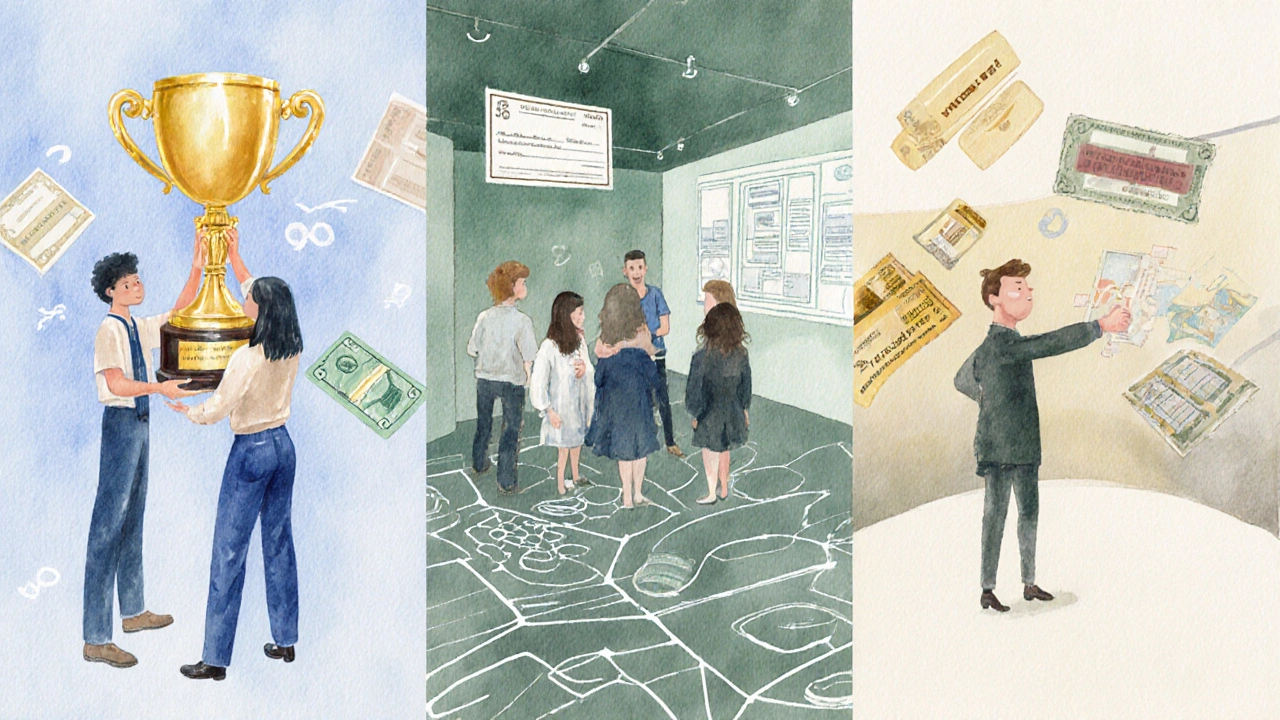MFA Program Acceptance Rate Calculator
Your Estimated Admission Odds
Quick Take
- Fully funded MFA programs cover tuition, fees, and usually a living stipend.
- Acceptance rates range from 5% at top schools to 25% at mid‑tier institutions.
- Strong portfolio, clear artistic vision, and solid academic references are non‑negotiable.
- Most schools award funding via fellowships, teaching assistantships, or project‑based grants.
- Start preparing 12‑18 months before deadlines and treat every requirement as a chance to showcase your potential.
When you hear the phrase fully funded MFA is a Master of Fine Arts graduate program that covers tuition, fees, and often a living stipend for admitted students, it sounds like a golden ticket for artists who want to study without drowning in debt. But the reality is that these spots are limited, competitive, and require a strategic approach. Below we break down exactly how hard it is to get in, what schools look for, and how you can stack the odds in your favor.
What Does "Fully Funded" Actually Mean?
In the art world, "fully funded" usually means three things:
- Tuition is waived.
- Fees (studio supplies, technology, health insurance) are covered.
- A stipend-often $15,000-$30,000 annually-is provided to cover living costs.
Some programs also throw in health benefits or travel grants for exhibitions. The exact package varies by institution, so always check the school’s financial‑aid page for the fine print.
How Selective Are Fully Funded MFA Programs?
Admission rates differ dramatically based on reputation, location, and discipline (painting vs. video, for example). Here’s a snapshot from the latest data (2024‑2025 cycle):
- Top-tier schools (e.g., Yale School of Art, Rhode Island School of Design) - 4%-7% acceptance.
- Mid‑tier schools (e.g., School of the Art Institute of Chicago, Savannah College of Art & Design) - 12%-20% acceptance.
- Regional programs (e.g., University of Canterbury, New Zealand; University of Texas at El Paso) - 20%-30% acceptance.
Because funding slots are usually a subset of total enrollment, the effective chance of landing a fully funded offer can be half the overall acceptance rate. If a school admits 100 students and funds 30 of them, you’re looking at roughly a 3%-10% chance depending on the program.
Key Eligibility Criteria
Admissions committees weigh a handful of core elements. Below is a quick rundown, each with its own micro‑data tag for clarity.
Portfolio is the visual showcase of your best work, typically 12-20 pieces, that demonstrates technical skill, conceptual depth, and a coherent artistic voice. Schools grade portfolios on originality, consistency, and the ability to articulate a practice.
Statement of purpose is a 1-2 page essay explaining your artistic goals, why the specific MFA program fits, and how you plan to contribute to the community. A bland statement kills chances fast.
Letter of recommendation is a written endorsement from a mentor, professor, or professional who can speak to your creative potential and work ethic. Strong letters add credibility to the subjective aspects of the review.
Other factors include GPA (often not a deal‑breaker for art programs), prior exhibitions, awards, and relevant work experience. Some schools also require a GRE or language test for international applicants.

How to Strengthen Your Application
Think of each component as a piece of a puzzle. Pull them together thoughtfully, and you’ll stand out even in a low‑acceptance pool.
- Curate a focused portfolio. Rather than dumping every project, select works that speak to a single theme or methodology. Include brief captions that explain context and process.
- Craft a narrative‑driven statement. Start with a hook-perhaps a pivotal moment in your practice. Then connect that story to the faculty, facilities, and research opportunities at the target school.
- Secure tailored recommendation letters. Ask recommenders who know specific projects you’re highlighting. Provide them with your portfolio and statement so they can write targeted praise.
- Show professional engagement. List recent exhibitions, residencies, or publications. Even a solo show at a local gallery adds weight.
- Prepare for the interview. Many programs hold virtual or on‑campus interviews. Treat it like a portfolio presentation-practice talking through your work fluently.
One common mistake is treating the portfolio as a random collection. Remember the semantic triple: Portfolio[demonstrates]Artistic Vision. Your work must prove the vision you claim.
Funding Mechanisms Explained
Most schools bundle funding into a few standard packages. The table below compares the most common types.
| Funding Type | Typical Coverage | Stipend Range (USD) | Commitment Required |
|---|---|---|---|
| Fellowship | Full tuition + health insurance | $20,000‑$30,000 | None (pure merit) |
| Teaching Assistantship | d>Partial tuition + stipend$12,000‑$18,000 | 15‑20hrs/week teaching | |
| Project‑Based Grant | Materials + travel | $5,000‑$10,000 | Produce a final exhibition piece |
| External Scholarship | Varies (often tuition only) | $2,000‑$15,000 | Application essay, deadline‑specific |
| Self‑Funded (no award) | None | $0 | Pay tuition out‑of‑pocket |
Notice that fellowships are the rarest-often less than 10% of total spots. Teaching assistantships are the most common funding route, but they also demand time management skills.
Timeline & Action Plan
Planning ahead gives you a realistic chance to meet every deadline and polish each piece.
- 12-18 months before application: Research programs, note funding deadlines, and start building a cohesive portfolio.
- 9 months out: Reach out to potential recommenders, request feedback on your statement, and apply for external scholarships.
- 6 months out: Finalize portfolio images, write captions, and submit a draft of your statement for peer review.
- 3 months out: Complete any required tests (GRE, TOEFL), confirm recommendation letters are sent, and double‑check application portals.
- 1 month out: Submit applications, then prepare for possible interviews (mock sessions help).
Throughout the process, keep a spreadsheet tracking each program’s admission rate is the percentage of applicants who receive an offer of enrollment. Seeing the numbers side‑by‑side helps you prioritize where to invest extra effort.
Common Pitfalls and How to Avoid Them
- Submitting a generic portfolio. Tailor the work to each school’s strengths. If a program emphasizes digital media, include at least one compelling new media piece.
- Skipping the interview preparation. Treat it as a live portfolio review; rehearse answering why you need funding and how you’ll give back to the community.
- Applying too late. Funding offers are often made on a rolling basis. Early applicants can snag limited fellowships before they’re exhausted.
- Ignoring external scholarships. Many foundations (e.g., Fulbright, Arts Council) fund international MFA students. A modest grant can tip the scales.
- Underestimating the stipend. Calculate living costs for the city (Auckland, NewYork, London) and compare to the stipend range in the table; a shortfall means additional work‑life balance challenges.
By anticipating these hurdles, you keep your application on track and reduce the stress that often comes with graduate‑school hunting.
Frequently Asked Questions
What is the typical deadline for fully funded MFA applications?
Most U.S. programs close their fully funded application windows between early December and late February for a September start. International schools may have later deadlines, so always verify each department’s calendar.
Can I apply to multiple schools with the same portfolio?
Yes, but it’s smarter to tweak the selection for each school’s focus. Swapping in one or two pieces that align with a program’s faculty research can make a big difference.
Do fully funded offers ever come with a teaching requirement?
Most fellowships are pure merit and have no teaching duties. However, many schools bundle a stipend with a teaching assistantship, so you might accept both to secure full funding.
How does my GPA affect MFA admissions?
GPA is a secondary factor for most art programs. A strong portfolio can outweigh a sub‑average GPA, but a GPA below 2.5 may raise red flags unless compensated by exceptional work experience.
Are there fully funded MFA options outside the United States?
Absolutely. Schools in Canada, the UK, Australia, and NewZealand all offer funded spots, often through government grants or university scholarships. The funding structure can differ-some provide a flat stipend, others cover only tuition.

